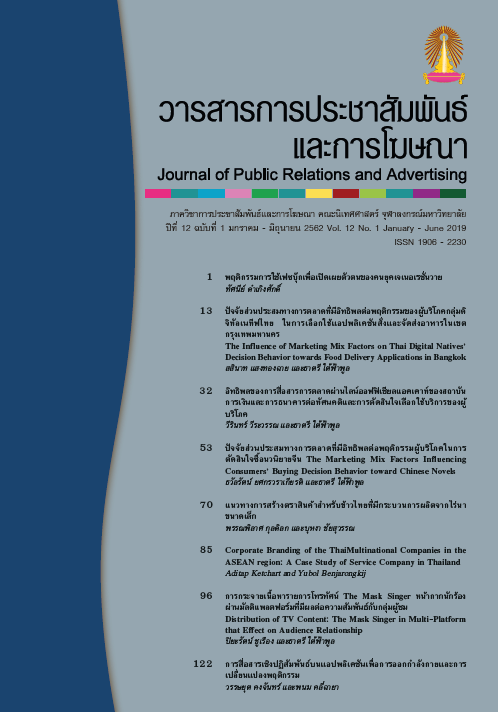Social Networks Usage Behavior for Self-Disclosure of Generation Y
Main Article Content
Abstract
The current study research aims to 1) investigate behaviors of generation Y people in using Facebook 2) to find out about self-disclosure patterns of generation Y people on Facebook. 3) to compare self-disclosure patterns of generation Y people in different age groups. The data collection tool was questionnaire. The data were statistically analyzed using percentage, mean, One-way Anova Analysis statistical package. The results of the study revealed that most research participants used Facebook through their phone at home. The participants used such social media to communicate with their close friends more than any other kinds of social media for relationship enhancement and maintenance. Self-disclosure information was provided by participants through personal information on their Facebook profiles.
Research hypothesis testing results
It was found that the participants with different age groups demonstrated their self-disclosure patterns differently. The difference is statistically significant at 0.05, which confirms the research hypothesis.
With regards to One-way Anova Analysis of Variance by pair to Schaeffer's test , it was found that the participants aged from 17 to 21 demonstrated the pattern of self-disclosure on Facebook more than the participants aged from 22 to 26, 27 to 31, and 32 to 35.
The patterns of the self disclosure demonstrated by participants aged from 22-26, 27-31, and 32-35 were identical.
Article Details
References
ขวัญเรือน กิติวัฒน์, (2531). สื่อมวลชนกับการสร้างความเป็นจริงทางสังคม, วารสารนิเทศศาสตร์.จุฬาลงกรณ์มหาวิทยาลัย.
ขวัญวิทย์ ตาน้อย. (2553). พฤติกรรมการใช้งานสังคมออนไลน์ของนักศึกษาระดับปริญญาตรี มหาวิทยาลัยเทคโนโลยีราชมงคลธัญบุรี. วิทยานิพนธ์บริหารธุรกิจมหาบัณฑิต,คณะบริหารธุรกิจ, มหาวิทยาลัยเทคโนโลยีราชมงคลธัญบุรี.
จิรภัทร เริ่มศรี. (2558) พฤติกรรมการใช้เฟซบุ๊กที่มีผลกระทบต่อนักศึกษามหาวิทยาลัยราชภัฏสกลนคร. คณะวิทยาการจัดการ มหาวิทยาลัยราชภัฏสกลนคร.
ชัชวาลย์ ทัตศิวัช. (2553). จูงใจคน GEN-Y (ตอนแรก). สืบค้นจาก http://www.jobpub.com/articles/showarticle.asp?id=2530.
ชานนท์ ศิริธร. (2554). การเปิดรับสื่อและการยอมรับนวัตกรรมของผู้บริโภคเจเนอเรชั่นเอ็กซ์และ เจเนอเรชั่นวาย. วิทยานิพนธ์ปริญญามหาบัณฑิต, จุฬาลงกรณ์มหาวิทยาลัย.
บุษบา สุธีธร.(2548). ทฤษฎีการสื่อสารภายในบุคคลและระหว่างบุคคล. ประมวลสาระชุดวิชาปรัชญานิเทศศาสตร์และทฤษฎีการสื่อสารหน่วยที่ 7. มหาวิทยาลัยสุโขทัยธรรมาธิราช.
พชร อินทร์เงิน. (2555). กลยุทธ์การสื่อสารตราสินค้าผ่าน Facebook Page: Spark by TMB. สารนิพนธ์ปริญญาบัณฑิต, มหาวิทยาลัยธรรมศาสตร์.
พิชญาณี ภู่ตระกูล.(2559) การเปิดเผยตนเองในเครือข่ายสังคมออนไลน์: แนวทางการศึกษา ปัจจัยที่มีอิทธิพล และผลกระทบ. วารสารพฤติกรรมศาสตร์เพื่อการพัฒนา. มหาวิทยาลัยศรีนครินทรวิโรฒ
ภานุวัฒน์ กองราช (2554) การศึกษาพฤติกรรมการใช้เครือข่ายสังคมออนไลน์ของวัยรุ่นในประเทศไทย กรณีศึกษา เฟซบุ๊ก. วิทยาศาสตรมหาบัณทิต มหาวิทยาลัยธรรมศาสตร์
วิมลพรรณ อาภาเวท, สาวิตรี ชีวสาธน์, ชาญ เดชอัศวนง. (2554) พฤติกรรมการสื่อสารในเฟซบุ๊ก ของนักศึกษามหาวิทยาลัยเทคโนโลยีราชมงคลพระนคร. วารสารวิชาการและวิจัย มหาวิทยาลัยเทคโนโลยีราชมงคลพระนคร
สรรค์ธนพงศ์ วงษ์ทองดี.(2556) การศึกษาพฤติกรรมการใช้เฟซบุ๊กของนักศึกษาระดับปริญญาตรีมหาวิทยาลัยเทคโนโลยีพระจอมเกล้าธนบุรี. ครุศาสตร์อุตสาหกรรมมหาบัณฑิต. เทคโนโลยีพระจอมเกล้าธนบุรี.
สิริเสาวภา ฤกษนันทน์.(2556) พฤติกรรมการสื่อสารและการเปิดเผยตนเองของผู้ใช้งานเว็บไซต์
เฟซบุ๊กในเขตกรุงเทพมหานคร. นิเทศศาสตรมหาบัณฑิต มหาวิทยาลัยศรีปทุม.
สุรพงษ์ โสธนะเสถียร. (2545). หลักและทฤษฎีการวิจัยทางสังคมศาสตร์. กรุงเทพฯ: โรงพิมพ์ประสิทธิ์ภัณฑ์แอนท์พริ้นติ้ง.
ภาษาอังกฤษ
Herbison, G. & Boseman, G. (2009). Here they come – Generation Y: Are you ready?, Journal of Financial Service Professionals, May, 33-34.
Joseph A DeVito (1978). Human Communication. The Basic Course.6Thed. New York:Herper Collins College Publishers,1994
Liu, D., & Brown, B. B. (2014). Self-disclosure on social networking sites, positive feedback, and social capital among Chinese college students. Computers in Human Behavior, 38, 213-219
Weaver II, R. L. (1993). Understanding Interpersonal Communication. New York, NY. Harper Collins College.
Xu, H., Dinev, T., Smith, H. J., & Hart, P. (2008). Examining the formation of individual’s information privacy concerns: toward an Integrative view. 29th Annual International Conference on Information Systems (ICIS) (pp.1-16). Paris
Yamane, T. (1973). Statistics: An introductory analysis (3 rd ed). New York: Harper and Row.
Yarrow, K., & O’Donnell, J. (2009). Gen buy: How tweens, teens, and twentysomethings are revolutionizing retail. Market Street, SF: A Wiley Imprint.


